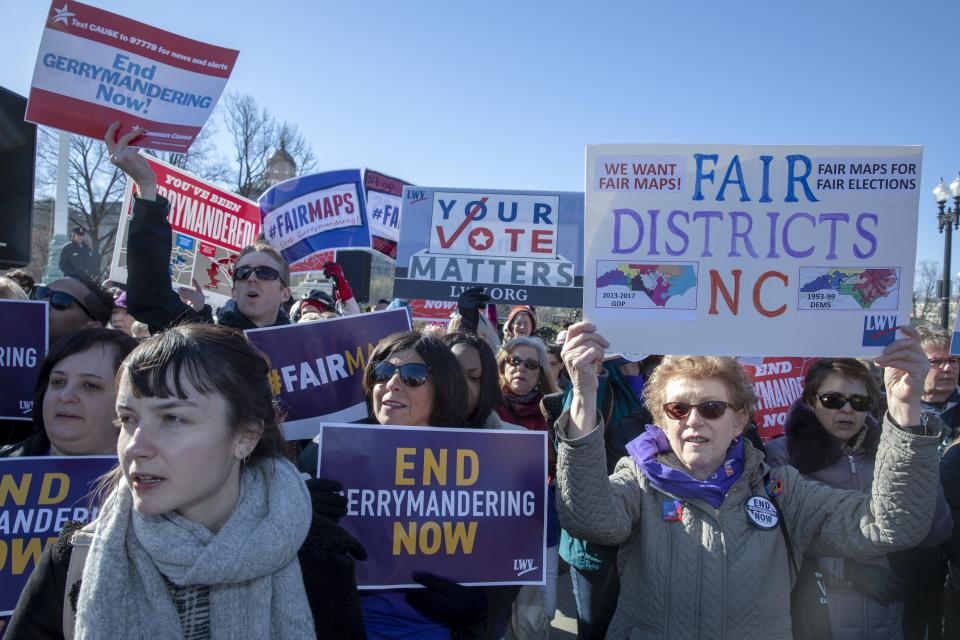House races were very uncompetitive in 2022. The 2024 elections are projected to be even worse.
House races during last year's midterm cycle continued to decrease in competitiveness, furthering an ongoing trend over at least the past decade, according to a new analysis.
FairVote, a nonprofit advocacy for election reform, published the 2022 Dubious Democracy report showing an overwhelming lack of competition in 2022 and that the smallest share of the population since 2014 elected the 118th U.S. House.
The number of competitive House seats has been shrinking for years, which FairVote describes in its report. In 2022, only 36 races were true toss-ups (where fewer than five percentage points separated winner and loser) compared to 44 races during the 2018 midterm elections.
It's not expected to get much better. FairVote's Monopoly Politics project estimates 85% of House seats in 2024 will be “safe” for one party, a factor that incentivizes partisanship in elections. Ahead of the 2022 cycle, 80% of House seats were projected "safe."
A number of factors account for the decrease in competitiveness: redistricting, gerrymandering — the drawing of congressional districts so that they benefit one party — and a larger demographic trend nationwide of more people living next to like-minded neighbors.
Here's what else to know:

Fewer U.S. House seats have any competition
An overwhelming majority of House races in 2022 — five out of six races, or 84% —were decided by more than 10 percentage points. The average margin of victory for winners in contested elections was 27 percentage points.
Out of the 435 races, two out of three were decided by 20 percentage points in 2022. Iin 2018, 80% of House races were decided by more than 10 percentage points and 61% were decided by 20 percentage points or were uncontested.
In total, 32 seats went uncontested by one of the major parties in 2022. In 2020 only 27 races featured only one major party candidate.
2016 Flashback: Fewer and fewer U.S. House seats have any competition
The 118th House elected by the smallest share of the population since 2014
FairVote calculates a "voter consensus" score based on how many eligible voters select House winners. Between 2014 and 2020 the voter consensus increased from 23% to 34%. But in 2022 that figured dropped to 24%, meaning less than a quarter of voting-age Americans voted for a current House member.
"It’s no surprise that Americans don’t feel represented by Congress – most of us didn’t vote for them," said Rob Richie, President and CEO of FairVote, in a statement. "Competition is down, partisanship and gridlock are up, and the vast majority of voters are trapped in one-party districts where our votes don’t make a difference."
FairVote has championed the Fair Representation Act, which pushes for ranked-choice voting and multi-member districts. Rep. Don Beyer, D-Va., introduced the bill during the 117th Congress in 2021 but it saw little traction.
Redistricting: Voters get fewer choices as Democrats and Republicans dig partisan trenches
Decreasing incumbent advantage
Incumbent lawmakers generally have an advantage while running for office. Yet FairVote's Monopoly Politics project showed the incumbency bump hit a 25-year low in 2022.
Incumbents only saw a 1.3 percentage point boost compared to non-incumbents, a historic low since FairVote began tracking the incumbency boost in 1996.
What's to come in 2024
FairVote projects that in 2024 there will be a record 369 safe races — the highest since 1996 — and only 25 true toss-up races, the second-lowest since 1996.
Still, there are some very competitive contests next year. There are 23 "crossover" House members – lawmakers who won despite representing districts where most voters went for the presidential candidate of the opposite party. Of those, nine incumbents are the most vulnerable of losing to a candidate from the other party going into 2024, according to the group.
Democratic Rep. Mary Peltola of Alaska
Democratic Rep. Jared Golden of Maine
Democratic Rep. Marie Gluesenkamp Perez of Washington
Democratic Rep. Marcy Kaptur of Ohio
Democratic Rep. Matt Cartwright of Pennsylvania
Republican Rep. John Duarte of California
Republican Rep. Mike Garcia of California
Republican Rep. David Valadao of California
Republican Rep. Anthony D'Esposito of New York
This article originally appeared on USA TODAY: Most House lawmakers represent uncompetitive congressional districts

